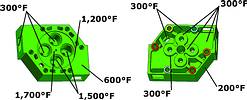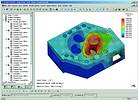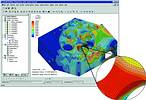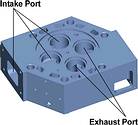Multiphysics analysis to simulate cylinder head
December 2003

Diesel engines are being researched for use in military vehicles because of their competitive fuel economy and operating costs. Adiabatics Inc used multiphysics FEA software from Algor to study the thermal and structural behaviour of a cylinder head for a diesel engine that would provide reduced heat rejection and increased power density while maintaining its superior fuel economy and lower operating cost. This work was part of the contract awarded by Tank-Automotive & Armaments Command – a division of the US Army.

Pushing for more power
Diesel engines have better fuel economy and lower operating costs than the turbine engines typically used in tanks, which have a higher power density and higher fuel consumption. The proposed idea was to come up with a design modification of an existing diesel engine that would result in reduced heat rejection and increased power density.
In the prototype of the altered diesel engine, temperatures at certain portions of the stainless steel cylinder head were measured at 870°C - almost twice the normal operating temperature of 420°C-480°C. At these high temperatures, the cylinder head within the diesel engine was developing valve-insert and head-gasket combustion leaks, all due to local head distortion. Finite element analysis was necessary to evaluate the design and material used for the cylinder head and hence verify that the high temperatures were in fact causing the leaks.

Multiphysics analysis of the cylinder head
Adiabatics engineer, Vishwas Bantanahal, began with a Pro/Engineer solid model consisting of the cylinder head and six washers. He used Algor's InCAD technology to capture the geometry and create a three-dimensional (3D) finite element mesh.
"Algor's InCAD technology enabled me to easily and directly capture a CAD assembly and create a solid mesh of the assembly," he said. "This direct CAD/CAE data exchange is much easier than other methods, such as using an intermediate universal file format.
"Small holes and cuts were suppressed to prevent stress concentrations and to obtain a better understanding of the overall stress distribution in the model," he said. "I also refined the mesh around the holes and fillets in the final model. Even though this was one of my initial projects with Algor software and taking into account that I already had considerable experience with other FEA software, I was impressed with how easy to use and effective Algor's meshing and mesh refinement tools were."

The model was set up for a steady-state heat transfer analysis. Stainless steel AISI 410 was the material used for the prototype cylinder head and steel was used for the washers. The washers were only modelled to obtain a uniform circular cross-sectional area for the application of the loads caused due to the tightening of the bolts.
The temperatures on the different surfaces of the cylinder head were determined using data obtained through previous cycle simulation tests for an intake air temperature of 600°F. These temperatures along with the related convection coefficients were applied as input for the heat transfer analysis.
As expected, the heat transfer analysis revealed high temperatures on the walls of the exhaust port, ranging from 400°C to almost 800°C with the interface (bridge-like) region between the two exhaust valves reaching the highest temperatures.

The temperatures obtained from the steady-state heat transfer analysis were then applied to a linear static stress analysis where only thermal stresses were considered. "Through preliminary analyses, I discovered that other effects such as the mechanical loads caused by the tightening of the bolts on the cylinder head did not contribute much towards the stresses when compared to the high temperatures," said Bantanahal.
The highest stresses were found at the interface between the two exhaust ports where temperatures were also the highest. "The stresses across other regions of the cylinder head fell well below the yield point of the material," points out Bantanahal. "However, near the exhaust port region, stresses ranged from 586 MPa to over 1,4 GPa, which is well above the yield point of the material at the temperatures predicted by the heat transfer analysis. So, some local yielding could be expected."
The linear static stress analysis confirmed the behaviour that engineers saw in the initial prototype tests. "The highest thermal stresses coincided with the part of the cylinder head that had been leaking in the preliminary prototypes," he continued. "It was clear from these analyses that either the cylinder head or the operating parameters would need to be changed to ensure that the final design performs adequately."
Although the linear static stress analysis predicted failure, Bantanahal did not choose to do a nonlinear analysis. "Ideally, this part should stay well within the linear range. Once it has yielded, you would not want it to still be operating inside the engine," he said.
The strength for most metals, such as stainless steel, drops considerably at temperatures greater than 760°C. The most obvious way to increase the durability of the cylinder head is to choose a different material that has appreciable strength at very high temperatures (around 690-1000 MPa at 870°C-980°C). Another option would be to use a specialised thermal barrier coating (TBC), one of Adiabatics specialties, to protect the head from wear and tear due to the thermal stresses. Research is currently in progress to make the cylinder head more durable while maintaining the operating parameters that reduce heat rejection and increase the diesel engine's power density.
Visit www.algor.com for more information.
Others who read this also read these articles
A challenge for motor manufacturers
Computer-based integration of design and manufacturing is essential for the '24-month car' to be achieved[ October 2004 ]
Prominent new lifestyle centre for Cape Town's financial district
Dimension Modeling created the 3D interior models that were then also rendered out for internal views of the apartments as well as the atrium and foyer areas[ August 2004 ]
Anglo Platinum - automating repetitive design tasks with Solid Edge
Solid Edge Insight is an innovative solution that seamlessly integrates CAD, design management and Web-based collaboration into a single tool that is easy to implement and easy to manage[ June 2004 ]
Styled plastic products and packaging - main pains and solution initiatives
To put the product and the customer front and centre, where they belong, all disciplines must sit at the same virtual table, sharing the same information and seeing the same vision[ June 2004 ]
Evolution from 2D to 3D - a product development manager's perspective: Part II
Whereas 2D CAD shortens time scales to some extent, 3D CAD goes much further, directly supporting the whole product development cycle, speeding up every activity and increasing the quality of design by removing many sources of inaccuracy and error[ April 2004 ]
Unigraphics NX 2: the next generation
What the NX 2 release sees is the integration of the use of networks of curves to define surface boundaries and existing geometry, and freeform surface modelling into the core of Unigraphics but with a few rather neat extras as well[ October 2003 ]
Geopak helps create Festival City
Geopak Site allows one to handle with ease live 'what if' scenarios with the client and other design team members[ August 2003 ]
Desktop product has new features and enhancements
Engineers can accurately and quickly simulate one body rolling or sliding on another body, in three dimensions such as in cam and latch designs[ August 2002 ]
Others who read this also read these news items
Lockheed Martin selects preferred MCAD tool
[ December 2005 ]
Grand scale initiatives at Ethekwini Municipality
[ October 2005 ]
Robert Mugabe Avenue in Windhoek gets extension
[ August 2005 ]
Strand7 nonlinear analysis used to solve bracket deformation problem
[ August 2005 ]
Scania optimises truck components
[ February 2005 ]
Delcam's PowerMILL chosen for A1 Grand Prix engine manufacture by Zytek
[ February 2005 ]
A first of its kind: irrigation development, a R3,7-billion SADC project
[ February 2005 ]
Arup lands Tianjin Olympic Aquatic Centre project
[ December 2004 ]
Others who read this also read these regulars
Search Site
Subscribe
Previous Issues
Other Technews Publications
Other Technews Buyers Guides
 |  | Copyright c1995-2009 Technews Publishing (Pty) Ltd.. All rights reserved. |